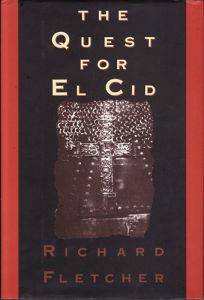After a year of almost exclusive focus on Napoleonics I am now returning to the promiscuous reading selection of old. One of the books I had been saving up for this moment was Richard Fletcher's The Quest For El Cid. My interest in The Leader was aroused by my visit to Spain two years ago.
The beauty of the book is that it not only describes the life of The Cid, about whom there is only a limited amount of hard evidence, but also the Spain that he lived in, and also the Spain that turned him in to a crusader saint later on.
The age of El Cid was a fluid one, with disintegration of the old Muslim Caliphate into successor states that were unable to maintain themselves against Castilian expansion. So many of them became dependents, riven apart by internal struggle to be exploited by rising Christian states in the north. However, those fought amongst themselves as well.
Christians, Jews and Muslims lived among each other, just like Spanish born were mixed with Arab and Berber immigrants and descendants. Not that it was a multicultural paradise, but at least a period of relative tolerance (see my discussion of that topic earlier on this blog).
 |
| Spain in 1086, just before the coming of the Almoravids |
But that was about to change during The Cid's lifetime. On the one hand hard line Christians were starting to build a vision of reconquest, while from the North and South of the Sahara the strict Almoravid sect made rapid progress toward the Mediterranean.
The Cid was always more his own man than a courtly insider after he lost his royal patron early in life. He wasn't particularly liked and easily made enemies, but his skill at leading troops made him very useful to the leaders of his age. He served the king of Castile but also the Muslim leader of Zaragoza. And late in life he primarily served his own interest, capturing Valencia to rule himself.
In the last chapter Fletcher shows how the legend was built on this, partly from a need to attract pilgrims in monasteries and later from a need to build a reconquista ideology, and finally in the modern ago, the need to create a unifying myth for Spain.
Highly recommended, therefor
And yes, this is a perfect setting for a megagame.

The Fletcher book is one of my absolute favourites and a huge influence on my El Cid armies.
ReplyDeletePD
HI Peter, what do you mean by influence? There is not much in the book on military organisation or uniforms, but I can well imagine it was inspirational to pick the period
DeleteJ
ReplyDeleteActually the book didn't influence the armies directly so much as it influenced me to build the armies! It is a wonderful little volume, punches way above it's weight in terms of value. Mostly the book provides flavour and to me what this period is about more than anything else is flavour.
Cheers, PD
exactly my feeling. It has made this age come alive
DeleteVery nice post, thanks for sharing. One small correction, if you don´t mind - the map refers not to 1086, but to a much later epoch (1280) Portugal, for instance, only became a Kingdom in the 12th Century. Cheers!
ReplyDeleteThanks for that. No problem. The map say 1280 'era commun' which is not the same as anno domini. A quirk of this book publisher from Hungary. The actual year is 1086 as evidenced by the extent of Muslim ruled territory (much farther north than in 1280) and Toledo just added to Castile.
DeleteHi J de Jong:) You´re absolutely right, the Muslim area is much farther North than it was in 1280, and this map does coincide with its extent in the El Cid epoch. The "Era Comum" (Common Era) is equivalent to "Anno Domini"(Year of the Lord) - an alternative naming for those who want to avoid religious conotations: cfr. https://en.wikipedia.org/wiki/Common_Era . As you can see on the right side of this map, there is a "Reino de (Kingdom of) Portugal" which was founded in the 12th Century. By 1086, it didn´t exist, and the Portucalense County was still part of the Kingdom of Castille and Leon. Here´s a map of Iberia in the El Cid epoch, with more explicit political borders: http://www.libreria7soles.com/imagenes/mapas/M00-02G.jpg :) Cheers!
DeleteHi Jur ! Super post, and good to see Professor Fletcher's work being appreciated. It's an excellent book. I also really liked his book "Bloodfeud", which covers a similar exploration of late Dark Age history. Professor Fletcher's death a couple of years ago, and very shortly after retirement, was such a great tragedy. As you say, perfect material for one of your mega-games!
ReplyDeleteThanks for that suggestion, Sidney! I'll see if I can find Blood Feud.
DeleteI'll second Sydney's recommendation on the Bloodfeud book. It is good.
DeletePeter